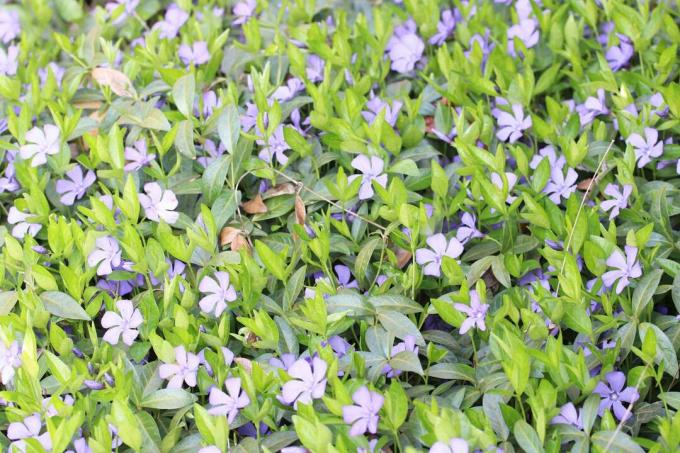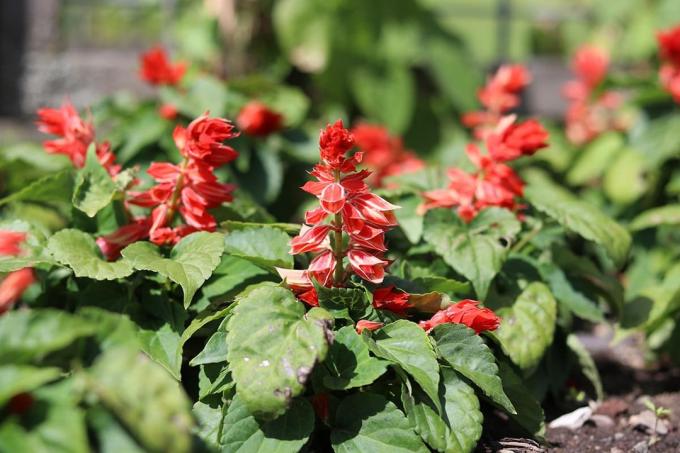

Table of contents
- Annual or perennial – tips for choosing
- Annual flowering ground cover
- Perennial flowering ground cover
- Worth knowing about annual and perennial ground covers in brief
Every garden has shady corners or slopes that can be beautified with groundcover. Alone on the bed, in colorful combinations or as an underplanting - the possible areas of application are diverse and allow a great deal of creative freedom. Of course, this is only true if the right species are selected.
Annual or perennial – tips for choosing
The distinction between annual and perennial flowering ground covers and plants in general is not always clear. And not always consistent. Not even if the classification is on the label or the seed bag. The reason for this lies in the winter hardiness of the plants. Many annual ground covers don't die because they really have a limited lifespan. Instead, they are simply not frost hardy. If they are still described as "annual", sowing is usually much easier and less expensive than overwintering indoors. At least when the seeds are sown directly in the garden and not cultivated in pots or tubs. Anyone who has the space available for safe overwintering and is planning a culture in the tub anyway should not prematurely part with a supposedly annual plant. The majority of these survive the winter surprisingly well and without any problems, provided they are kept frost-free.
Annual flowering ground cover
The particularly easy-care and yet decorative ground covers include:
Beach Silverweed
The beach silverwort originally comes from Madeira, but is finding more and more followers worldwide. Responsible for this is the undemanding thriving in sunny or semi-shady locations. And, of course, the white carpet of flowers that appears from June to December.
winch
The morning glory is a varietal plant that can spread quickly over large areas. It is therefore already considered a weed by some gardeners. However, it impresses with decorative flowers that appear on it from June to around October. In addition to the annual variants, the morning glory is also available as a perennial garden plant.
wild garlic
The wild garlic is not a typical ground cover in the garden, but a very handsome one. If kept sufficiently shaded and moist, it will spread quickly while making a delicious addition to the kitchen.
Nasturtium
The nasturtium is probably one of the best-known garden plants and is commercially available in many colors and cultivated forms. Actually perennial, it is usually used as an annual ground cover, since overwintering is difficult, at least outdoors in the garden.
pennywort or pennywort
The pennywort or coinwort grows to a height of just five centimeters and thrives best in partial shade. It can fill an important gap in the garden and is ideal as an underplanting and solitary ground cover. It flowers yellow and can also be perennial with appropriate protection.
chickweed
The chickweed is characterized above all by its great tolerance to drought and impresses with its silvery, velvety leaves, from which the white flowers stand out beautifully.
liver balm
The liver balm flowers violet and interestingly pinnate from May to October. If you want a particularly dense and magnificent flower, you should choose a sunny location.
Perennial flowering ground cover
On the side of the perennial flowering ground cover there is a large number of evergreen plants. The most undemanding include:
Small-leaved periwinkle
The small-leaved periwinkle is an approximately 20 cm high shrub that quickly grows over large areas and spreads densely.
Flowering occurs from May to September if a suitable location is chosen. Small-leaved periwinkles like shade or partial shade, making them ideal for underplanting.
cotoneaster
The cotoneaster is an undemanding plant that thrives almost anywhere and makes an appealing ground cover. The flowers and fruits are small, but contrast in color.
Johannis herbs
The yellow-flowering St. John's wort has become an integral part of many gardens and likes to fill shady or partially shaded areas. Because St. John's wort likes damp locations, it can also serve as a border for a garden pond.
stonecrop
The stonecrop is available in numerous cultivated forms and is particularly easy to care for. It can fill narrow niches or spread over large areas and feels particularly at home in the rock garden. If you really want little effort in the garden, the stonecrop is a good choice.
cushion bellflower
Cushion bellflowers form dense carpets, which are simply an eye-catcher with their bloom. They look very delicate and filigree, can be combined in many ways and can withstand a lot with sufficient watering. Sunny or semi-shady locations - the cushion bellflowers thrive very well in both.
Rosemary Daphne
Somewhat unusual and almost a rarity is the rosemary daphne. It blooms in pink or pink and tolerates drought very well, which is why it cuts a fine figure in the rock garden - but can also be kept in a bucket as an easy-care decoration.
scale heather
At least one heather species should not be missing from the list of easy-care, perennial and flowering ground covers. The perennial and handsome plants are small and low, but still spread quickly and vigorously. As long as they are not exposed to waterlogging, they prove to be robust garden plants.
Low checkerberry
The mulberry can grow quite light, but with the right care and a little pruning, it can also spread wonderfully densely. The brightly colored flowers and berries are eye-catching and can be seen almost all year round.
evening primrose
The evening primrose can stay very low, but with the right variety it can even grow up to two meters high. With yellow flowers, it brings sun under the partially shaded ground cover. If it is watered sufficiently, it also tolerates the sun well.
Worth knowing about annual and perennial ground covers in brief
Choosing the right varieties from the multitude of flowering ground covers is not always easy, because everyone is spoiled for choice. But those who have passed this can enjoy easy-care and attractive plants that require little effort. There are shady corners in every garden. These often appear monotonous and colorless in comparison to the rest. This need not be. There are a variety of beautiful and low-maintenance ground covers such as lily of the valley, ivy, periwinkle, golden strawberry, ornamental nettle, Balkan cranesbill and fat man, which require little care and let the bare corners flourish.
For the period from December to March Christmas rose excellent for shady corners. It is in its heyday during these months. After that, they delight wood anemone, which bloom from March with white and blue flowers, the eye as well as commemorative or leather flowers. Larkspur, for example, flowers in April and May. This is followed by the time for the red stonecrop, star umbels and false poppies. Autumn then belongs to the autumn anemones, the hardy outdoor fuchsias and the aconite. These are plants that bloom into October.
A notice:
Most plants are best planted in large groups. This allows them to spread and then cover a large area in colorful bloom. This looks beautiful.
- However, before you decide on a groundcover plant, it makes sense to know the soil conditions.
- Ground covers, which usually get along well with life in the shade, make different demands on the soil.
- Only on suitable soil can they thrive and fulfill their purpose of enlivening the bare spots with colorful flowers.
 garden editorial
garden editorial I write about everything that interests me in my garden.
Learn more about perennials

20 hardy plants that bloom all year round
With plants that flower all year round, you can quickly create an attractive garden that does not require much maintenance, as long as the plants are also hardy. In this post, we will introduce you to 20 plants that are suitable for this.

17 flowering hardy plants May to October
Many plants only show their full splendor for a short time. But there are also types and varieties with a particularly long flowering period from May to October, sometimes even longer. We present 17 flowering hardy plants.

Hardy perennials: 22 perennial bloomers
Hardy perennials as permanent bloomers in the flower bed enchant the garden from early summer to autumn with a colorful bloom. They are easy to care for and magically attract butterflies, bees and the like.

10 care tips for the banana tree
If you like it exotic, cultivate a banana tree as a houseplant or in the conservatory. In summer, the banana plants are even allowed outside for a few weeks. The large leaves that the Musa forms on a false trunk are particularly decorative and impressive, and therefore look like a small tree.

Properly care for globe thistle | 10 tips for care
The globe thistle is an eye-catcher in the garden. Their spherical flowers provide a food source for insects. The globe thistle is not difficult to care for and it is suitable for dry locations. With a few tips on care, the plants will develop even better.

Fire sage, Salvia splendens: care from A to Z
Fire sage is known in botanical jargon as Salvia splendens and is a particularly decorative eye-catcher. But what kind of care does the plant need? Our guide to the salvia shows the important points from A to Z.

